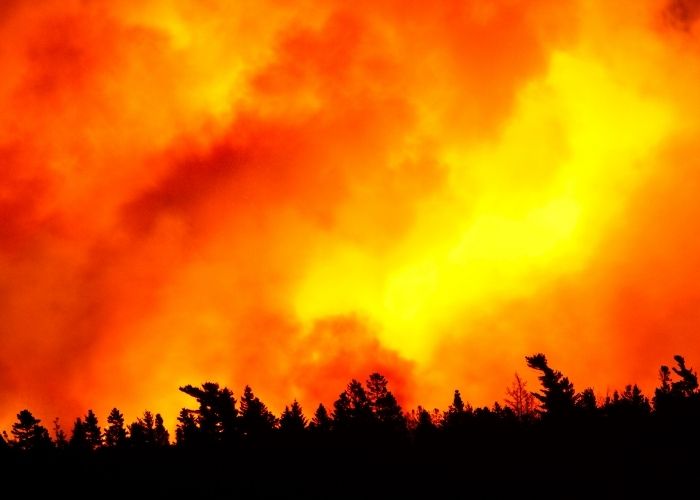MADRID – Why is the fire at Estepona called a sixth generation and what is the danger? Víctor Resco, professor of forestry at the University of Lleida, said this fire is “a foretaste of what could happen if we don’t act.”
Resco explains in the program Al Rojo Vivo of broadcaster La Sexta that the Sierra Bermeja fire in Malaga is a fire of a type for which there is no data yet. The fire has been raging since this Wednesday and more than 7,400 hectares have already burned down. On Sunday, six villages had to be evacuated. On Saturday the Andalucian president Juanma Moreno confirmed the forest fire was intentionally lit.
What does a fire of this magnitude in the Sierra Bermeja teach us?
Resco predicts a general trend that we are entering an era of fires that we cannot extinguish, fires that completely overwhelm the existing extinguishing capacity. The Sierra Bermeja had a natural fire regime, forest fires are part of the Mediterranean climate. In the maritime pine forests or areas with the Andalucian spruce, a surface fire of low intensity rages on average every 15 years.
These forest fires were positive in a sense, Resco said, because the fire removed the bushes between the trees, so that the trees, which did not burn completely, received more water afterward. This allowed them to grow better and recover well. The problem with fires of this intensity is that they also burn the crowns of trees and cause very high deaths of the trees leading to ecological and health problems for people.
What is a sixth-generation fire?
The forestry expert explains that the concept of generations was used to describe how fire behaviour has evolved since they started to be a problem in the 1950s or 1960s to the present day. “We’ve seen, more or less, that there is a change in behaviour every 10 years and these sixth-generation wildfires are capable of changing the weather around them.
In this case, for example, we see a pyrocumulus or even two forms of it every day. It’s a fire of such power, which discharges so much energy that it is able to create its own meteorology, its own cloud, its own convective column,” he explains. These clouds can sometimes “generate second fires.”
Priority to the evacuation of the people
Resco continues: “It’s like opening the chimney, but on a colossal scale”. He then warns of the biggest problem with these fires: When night falls and the humidity rises and the temperature drops, that cloud can collapse, endangering the safety of the entire extinguishing operation. That is why he emphasises that it is very important to give priority to ‘the evacuation of the people”.
Clear trend
The only hope for the Sierra Bermeja and the Valle Genal now is that it will rain. According to Resco, this fire in Sierra Bermeja is not an event in itself, but a very clear trend. “These types of fires are becoming more and more common. The first time we saw these very intense fires was in 2017, in Portugal, where 67 people died in the June fire. More recently, the fires in Ávila and Tarragona, as well as those on the Canary Islands in 2019. Another example of these fires was seen in California. This destroyed more than 500,000 hectares in 2018 and killed nearly 100 people.
‘The fires exceed our extinguishing capacity’
“These are faster and more aggressive fires where the fire can exceed a speed of 4,000 hectares per hour. That is between six and 12 times the speed of a normal fire. The mass of fuel is so great that fire changes weather conditions, causing vortices and storms. So great that they exceed the extinguishing capacity.”
Other factors
According to Resco, these sixth-generation fires are also influenced by other factors. Such as climate change, depopulation of the rural environment, and abandonment of the mountains. Also, humans regularly cause fires. Sometimes through carelessness, or as in the case of the current fire in the province of Malaga, intentionally. “It is a generation of fires that are difficult to control and have reached our country”.
Climate change threatens forests where there were previously no fires
The problem will increase because we have forested areas with high continuity of fuel. The plant mass is completely connected, as in the Pyrenees. Currently, there are no fires there because it is humid. But as climate change progresses and if we do not proactively manage the plant masses, they will become highly flammable. “We’re seeing a foretaste of what could happen if we don’t act.”
‘Only way is to prevent them from arising’
According to the expert, there is only one way to control the firefight: “before it happens”. “These fires are virtually impossible to put out,” he warns. A fourth or fifth-generation fire already exceeds the current extinguishing capacity. If the flames are more than three metres high, they generate enough energy that the water poured onto them from the air does nothing. “The sixth generation of fires is even more virulent,” clarifies Resco.
More prevention measures are urgently needed. For example, landscape management, control in the forests, informing citizens, mitigating climate change, and trying to restore the natural regime of fires. He points out that now fires are extinguished as quickly as possible and that means losing the chance that small fires can eliminate the undergrowth and undergrowth. Subsequently, this creates much larger accumulations of fuel, which again increase the risk of an all-consuming fire.


